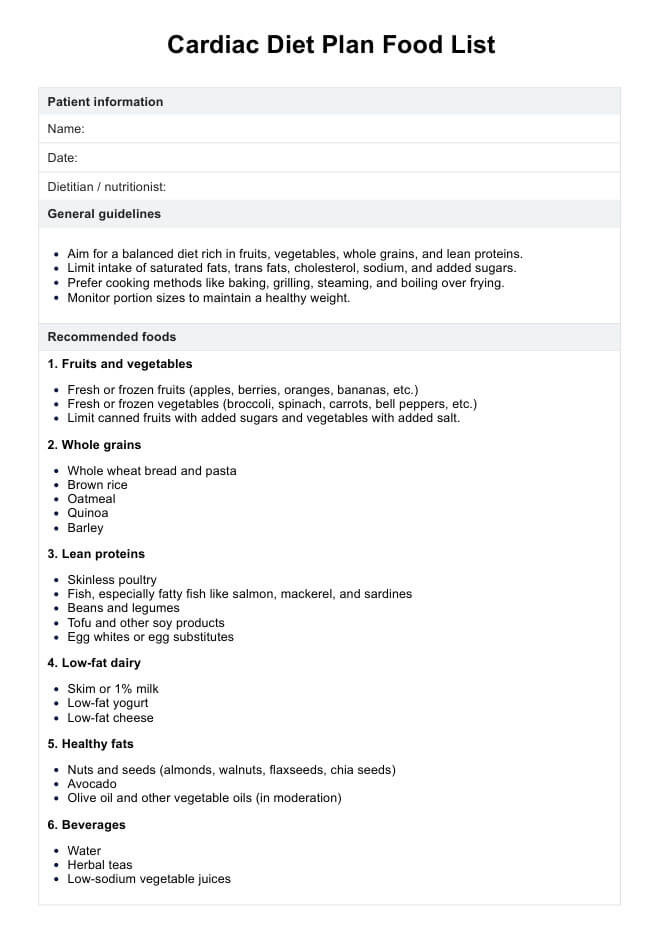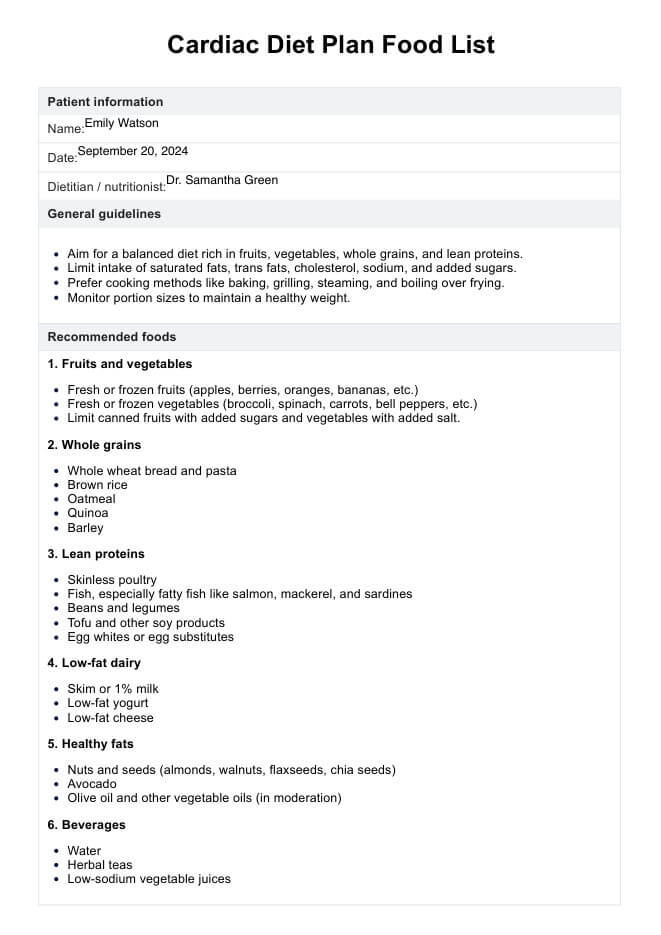Cardiac Diet Plan Food List
Enhance heart health with our Cardiac Diet Plan Food List PDF. Learn how to use it effectively and provide personalized patient care.


What is a Cardiac Diet Plan Food List?
A Cardiac Diet Plan Food List is a crucial component of a heart-healthy lifestyle, specifically designed to reduce cardiovascular risks and promote overall heart health. The cardiac diet meal plan includes foods that support cardiovascular function by lowering high blood pressure, cholesterol, and inflammation — key contributors to heart disease. The diet emphasizes heart-healthy choices like fruits and vegetables, whole grains, and fish while guiding dining out and making lifestyle adjustments for maximum effectiveness.
This diet focuses on nutrient-dense foods low in saturated fats, trans fats, sodium, and added sugars. Whole grains are highlighted for their fiber content, which aids in managing cholesterol levels. Fruits and vegetables, whether fresh or frozen, are integral for their rich supply of vitamins, minerals, and antioxidants that help combat oxidative stress linked to heart disease. Frozen vegetables are especially notable for retaining their nutritional value, as they are often frozen at peak ripeness.
Lean protein sources, such as lean meats like poultry and 95% extra lean ground beef, fish, legumes, and plant-based proteins, are favored over red and processed meats due to their lower unhealthy fat content, which helps protect heart health. Incorporating low-fat dairy products can further reduce saturated fat intake while boosting the intake of unsaturated fats, which benefits cardiovascular health. Fatty fish like salmon and mackerel are particularly encouraged for their omega-3 fatty acids, which provide heart-protective benefits.
Furthermore, healthy fats from avocados, nuts, seeds, and olive oil offer essential fatty acids and help absorb fat-soluble vitamins, contributing to a well-rounded, heart-healthy diet.
Cardiac Diet Plan Food List Template
Cardiac Diet Plan Food List Example
How to use our Cardiac Diet Plan Food List template
Our Cardiac Diet Plan Food List template, is designed to help you effectively guide your patients toward a heart-healthy lifestyle. Following this template, you can provide clear dietary recommendations to reduce cardiovascular disease risks. Here’s how you can use the template to support your patients:
Step 1: Download the template
Start by downloading the Cardiac Diet Plan Food List template from the Carepatron platform. You can easily access it via the link on this page, the Carepatron app, or our resources library.
Step 2: Review and customize the template
Before using it with your patients, review the template and customize it to fit each patient's specific dietary needs and preferences. This might include adjusting portion sizes, modifying food options based on allergies or intolerances, or emphasizing certain food groups based on the patient's health status.
Step 3: Discuss the diet plan with your patient
Use the template as a tool during patient consultations to explain the importance of a cardiac diet and heart-healthy eating. Discuss the recommended heart-healthy foods, those to limit or avoid, and how these choices can positively impact heart health. Ensure the patient understands each section and feels comfortable following the plan.
Step 4: Document the patient’s dietary preferences and restrictions
Fill in the additional notes section with any specific dietary restrictions, allergies, or personal preferences your patient may have. This ensures the diet plan is tailored to their needs and increases the likelihood of adherence.
Step 5: Monitor and update the plan regularly
As your patient progresses, use the template to monitor their adherence and make any necessary adjustments. Regularly updating the diet plan based on their progress, lab results, or health status changes will help maintain optimal heart health outcomes.
Benefits of using our template
Incorporating our Cardiac Diet Plan Food List template into your practice can significantly enhance the care you provide to your patients. Below are three key benefits that make this template an essential tool for healthcare professionals.
Enhances patient adherence
A clear, structured diet helps your patients understand exactly what they should eat and what processed foods to avoid. This level of clarity fosters better adherence to the recommended diet, ultimately leading to lower blood pressure, improved heart health, and more successful long-term outcomes.
Simplifies dietary counseling
The template serves as a practical guide during dietary counseling sessions, allowing you to convey complex nutritional information in a way that’s easy for patients to understand. This simplicity makes your consultations more efficient and ensures patients fully grasp the importance of following a heart-healthy diet.
Supports personalized care
With the template’s customizable features, you can tailor the diet plan to meet each patient's heart-healthy eating needs. This personalization allows you to address specific health conditions, cultural food preferences, and lifestyle factors, ensuring that each patient receives relevant and actionable care.
Key considerations for a heart-healthy diet
When implementing the Cardiac Diet Plan Food List with your patients, several important factors must be considered to ensure its success. First, it is crucial to educate your patients thoroughly about the reasons behind each dietary recommendation. Explaining how certain foods support heart health while others may contribute to the risk of heart disease empowers patients to make informed choices about heart-healthy foods and improves adherence to the plan. Discussing the negative impacts of saturated fats on heart health and the importance of replacing them with healthier fats is also essential.
Another critical consideration is regular monitoring of patient progress. Frequent follow-ups allow you to assess how well the patient is sticking to the diet and evaluate its effectiveness. During these check-ins, you can make necessary adjustments to the diet plan based on the patient’s progress, lab results, or any changes in their health status.
Finally, always customize the heart-healthy diet plan to fit each patient’s needs. When tailoring the diet, consider individual health conditions, lifestyle factors, and cultural food preferences. This personalized approach supports better patient adherence and enhances the overall effectiveness of the dietary intervention, leading to improved heart health outcomes.
Commonly asked questions
A cardiac diet should prioritize foods rich in nutrients that support heart health, such as fresh whole fruits and vegetables, whole grains, lean proteins like fish and poultry, and healthy fats from sources like nuts, seeds, and olive oil. These foods help reduce cholesterol, lower blood pressure, and minimize inflammation.
The cardiac diet plan should be reviewed regularly with your patient, ideally during each follow-up appointment. Frequent reviews help assess heart-healthy diet adherence, monitor patient health status changes, and make necessary adjustments to optimize heart health outcomes.
Yes, the cardiac diet plan can and should be customized to accommodate any additional health conditions a patient may have, such as diabetes or kidney disease. Adjusting the diet to align with a patient's needs ensures comprehensive care and better health outcomes.

.jpg)








































































































